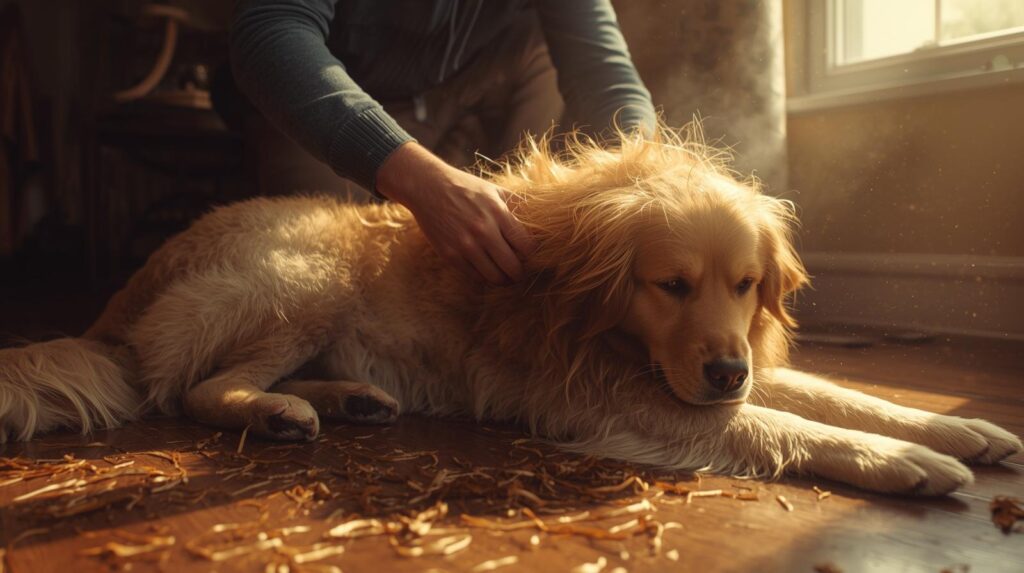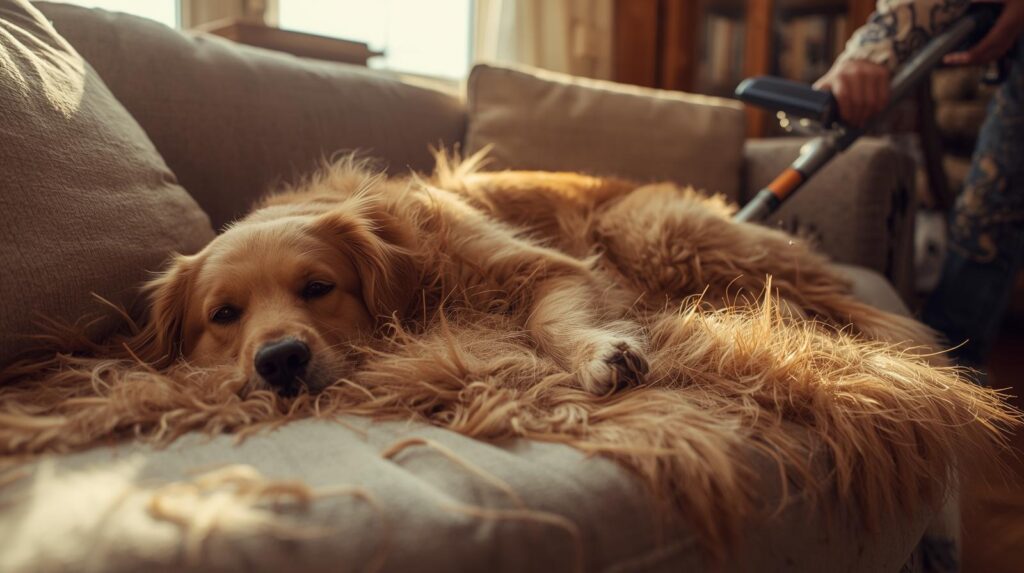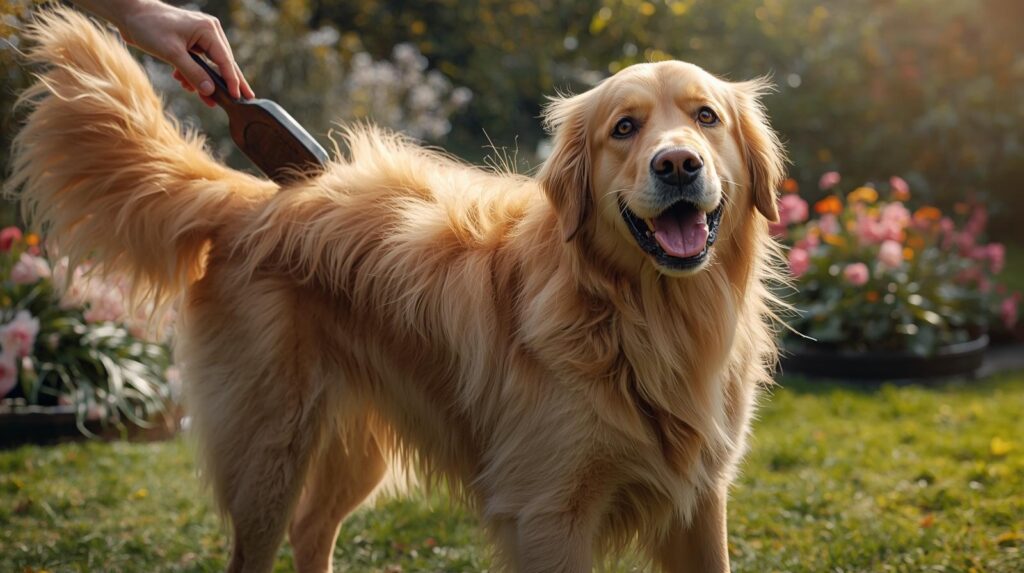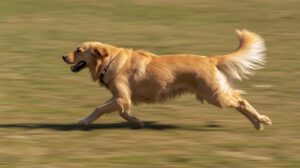Do Golden Retrievers Shed? The Truth Every Owner Needs

If you’ve ever spent five minutes with a golden retriever, you’ve probably noticed something: golden fur. Everywhere. On your clothes, your furniture, your carpet even in places you didn’t know fur could reach. I remember the first time I visited my friend’s home after she adopted her golden, Bailey. Within minutes, my black pants looked like they’d been dipped in gold glitter. She laughed and said, “Welcome to life with a golden!”
So, do golden retrievers shed? The answer is an emphatic yes. Golden retrievers are heavy shedders, releasing fur continuously throughout the year with intense seasonal periods. But understanding why they shed, when it peaks, and how to manage it can transform this challenge into something completely manageable.
Why Do Golden Retrievers Shed So Much?
Understanding the Double Coat Structure
The reason golden retrievers shed extensively lies in their unique double coat system. Golden retrievers possess a double coat consisting of longer, water-resistant guard hairs on the outer layer and a dense, soft undercoat that sits close to the skin for insulation. This sophisticated fur architecture serves multiple purposes protecting them from harsh weather, regulating body temperature, and shielding their skin from environmental hazards.
The outer coat gives goldens their signature lustrous appearance, while the undercoat acts as natural insulation. During temperature changes, this undercoat becomes the primary source of shedding as your golden’s body adapts to seasonal shifts.
The Science Behind Heavy Shedding
According to the American Kennel Club, golden retrievers are classified as heavy shedders, with most owners reporting daily shedding that increases significantly during seasonal changes. This shedding pattern isn’t a flaw it’s a natural biological process that helps dogs regulate their body temperature and remove damaged or old hair.
Veterinary sources from 2024 confirm that golden retrievers typically shed more visible volume than Labrador retrievers because their longer guard hairs make shedding more noticeable around the home.
When Do Golden Retrievers Shed Most?

Year-Round Shedding Pattern
Do golden retrievers shed all year? Yes, absolutely. Healthy golden retrievers shed continuously throughout the year, though owners typically see slightly less fur during summer and winter months compared to transitional seasons.
Seasonal “Coat Blowing” Periods
The most intense shedding occurs twice annually during what groomers call “coat blowing” seasons:
| Season | Timing | Duration | Intensity | Purpose |
|---|---|---|---|---|
| Spring | March – May | 3–4 weeks | Very Heavy | Shedding winter coat for summer |
| Fall | September – November | 3–4 weeks | Very Heavy | Replacing summer coat with winter coat |
The coat-blowing process typically lasts up to three weeks each time, during which golden retrievers transition from their thick winter coat to a lighter summer coat in spring, and vice versa in fall.
According to a 2024 survey by the National Dog Groomers Association, 85% of golden retriever owners report increased shedding during spring, making this the most challenging period for managing loose fur.
Factors That Influence How Much Golden Retrievers Shed
Genetics and Breeding Lines
Not all golden retrievers shed equally. Some bloodlines naturally produce dogs that shed more heavily than others, though all goldens shed noticeably regardless of their specific lineage.
Diet and Nutrition Impact
A balanced diet rich in omega-3 and omega-6 fatty acids promotes healthier coats and can potentially reduce excessive shedding. Quality nutrition directly affects skin health, hair follicle strength, and coat condition.
I’ve seen this firsthand with my neighbor’s golden, Max. After switching to a premium food with added fish oil supplements, she noticed his coat became shinier and the amount of loose fur around her house decreased noticeably within six weeks.
Health and Medical Conditions
Health issues such as allergies, skin conditions, or hormonal imbalances may increase shedding beyond normal levels. If you notice sudden excessive shedding, bald patches, or skin irritation, consult your veterinarian immediately.
Climate and Environment
Dogs living in warmer climates may shed more consistently throughout the year, while those in cooler regions typically experience more pronounced seasonal shedding patterns. Indoor temperature control can also affect shedding cycles.
Age-Related Changes
Puppies and senior dogs exhibit different shedding patterns. Golden retriever puppies shed their puppy coat between 6 and 12 months of age, during which they may shed more than usual as they transition to their adult double coat.
How to Manage Golden Retriever Shedding
Brushing Schedule and Techniques
Do golden retrievers shed less with regular grooming? While grooming won’t stop shedding, it dramatically reduces loose fur around your home.
Recommended Brushing Frequency:
- Regular seasons: 3-4 times per week
- Peak shedding seasons: Daily brushing
- Duration: 15-20 minutes per session
Veterinarians recommend brushing golden retrievers 3-5 times weekly with deshedding tools, slicker brushes, or undercoat rakes to remove loose hair and minimize fur accumulation in the house.
Best brushing tools for golden retrievers:
- Undercoat rake for removing loose undercoat
- Slicker brush for outer coat maintenance
- Deshedding tool for seasonal coat blowing
- Metal comb for checking for mats and tangles
Bathing Strategy
Bathing golden retrievers once monthly can help loosen dead fur, but avoid over-bathing as it can dry out the skin and potentially worsen shedding. Use high-quality dog-specific shampoos that won’t strip natural oils from their coat.
During peak shedding seasons, a professional grooming session can make a significant difference. Pet owners who take their dogs to professional groomers do so an average of five times per year, with grooming appointments being particularly beneficial during heavy shedding periods.
Dietary Supplements
Supporting coat health from the inside makes a measurable difference. Quality supplements containing:
- Omega-3 fatty acids (fish oil)
- Omega-6 fatty acids
- Biotin
- Vitamin E
These nutrients strengthen hair follicles, improve skin condition, and promote a healthier, more resilient coat.
Environmental Management
Home care strategies:
- Vacuum at least 2-3 times weekly during regular periods
- Use lint rollers on furniture and clothing
- Invest in a vacuum designed specifically for pet hair
- Wash dog bedding weekly
- Use furniture covers on favorite resting spots
Common Myths About Golden Retriever Shedding
Myth: Shaving Reduces Shedding
The Truth: Shaving will not stop a golden retriever’s shedding and can actually be dangerous for the dog, as their double coat protects them from UV rays, temperature extremes, and skin damage. When shaved fur grows back, it will shed just as before but now your dog has lost critical protection.
Myth: Golden Retriever Puppies Don’t Shed
While young puppies shed minimally, this changes rapidly. Once they reach 6-12 months and transition to their adult coat, shedding becomes a daily reality.
Myth: Indoor Dogs Shed Less
Indoor temperature control can affect shedding patterns, but it doesn’t eliminate shedding. Indoor dogs may actually shed more consistently year-round since they’re not exposed to natural seasonal temperature variations.
The Growing Pet Grooming Industry
The challenges of managing dog shedding have contributed to explosive growth in the pet grooming sector. According to the American Veterinary Medical Association’s 2024 pet ownership data, 45.5% of U.S. households own a dog, driving increased demand for grooming services.
The U.S. pet grooming services market was valued at $2.06 billion in 2024 and is projected to grow at a CAGR of 6.7% through 2030, reflecting how seriously pet owners take coat maintenance and grooming needs.
Real-Life Experience: Living with the Shed

After years of helping friends and family manage their golden retrievers’ shedding, I’ve learned one crucial truth: preparation makes all the difference. My cousin Sarah adopted a golden retriever puppy named Sunny last year. She was overwhelmed at first golden fur appeared on every surface within days.
But after implementing a consistent grooming routine, upgrading her vacuum, and adjusting Sunny’s diet with her veterinarian’s guidance, the situation improved dramatically. She now brushes Sunny every evening while watching TV, turning grooming into quality bonding time rather than a chore.
“Do golden retrievers shed?” she jokes now. “Yes, but they shed love even more abundantly.”
Expert Tips for New Golden Retriever Owners
- Start grooming routines early – Puppies should become accustomed to brushing from 8 weeks old
- Create a grooming station – Designate a specific area with all your tools readily available
- Monitor shedding changes – Sudden increases may indicate health issues requiring veterinary attention
- Consider professional help – According to 2024 industry data, 84% of pet owners provide their dogs at least one annual professional grooming session
- Embrace the reality – Golden fur is part of the package with these incredible companions
For more comprehensive information about caring for your golden retriever, check out our Golden Retriever Guides covering everything from training to health care.
When to Worry About Excessive Shedding
While golden retrievers naturally shed heavily, certain warning signs require veterinary attention:
- Bald patches or thinning areas
- Red, inflamed, or irritated skin
- Excessive scratching or biting at skin
- Sudden dramatic increase in shedding
- Dull, brittle, or dry coat texture
- Hair loss accompanied by lethargy or behavior changes
These symptoms could indicate allergies, hormonal imbalances, parasites, nutritional deficiencies, or other health conditions requiring professional diagnosis and treatment.
Conclusion: Embracing Life with a Shedding Golden
So, do golden retrievers shed? Without question yes. Golden retrievers are prolific, year-round shedders with intense seasonal periods that challenge even the most prepared owners. But understanding their double coat structure, anticipating seasonal changes, maintaining consistent grooming routines, and supporting coat health through proper nutrition transforms this challenge into something entirely manageable.
The truth is, that golden fur on your favorite sweater is simply evidence of the unconditional love, loyalty, and joy these remarkable dogs bring into our lives. Every strand represents a moment of companionship, a wagging tail greeting, or a gentle nuzzle of affection.
With the right tools, techniques, and mindset, managing golden retriever shedding becomes just another small part of sharing your life with one of the world’s most beloved dog breeds. The question isn’t whether golden retrievers shed it’s whether you’re ready to embrace the beautiful chaos they bring.
Frequently Asked Questions
Q: Do golden retrievers shed more than other dog breeds?
A: Yes, golden retrievers shed significantly more than many breeds due to their thick double coat. They shed more visibly than Labrador retrievers and far more than single-coated breeds. However, breeds like German shepherds, Siberian huskies, and Alaskan malamutes shed comparably due to similar double coat structures.
Q: Can you stop a golden retriever from shedding?
A: No, you cannot completely stop golden retriever shedding it’s a natural, healthy biological process. However, you can significantly reduce loose fur through consistent brushing (3-5 times weekly), proper nutrition with omega fatty acids, regular bathing, and maintaining your dog’s overall health. Professional grooming during peak seasons also helps manage excessive loose fur.
Q: At what age do golden retrievers shed the most?
A: Golden retrievers shed most heavily during two life stages: (1) between 6-12 months when shedding their puppy coat and transitioning to their adult double coat, and (2) during seasonal “coat blowing” periods in spring and fall throughout their adult lives. Senior dogs may also experience increased shedding due to hormonal changes and health factors.
Q: Is golden retriever shedding worse in spring or fall?
A: Both spring and fall bring intense shedding periods, but many owners report spring shedding as slightly more noticeable. During spring, golden retrievers shed their thick winter undercoat to prepare for warmer weather, which can result in larger volumes of loose fur. Fall shedding replaces the summer coat with a denser winter coat, creating equally significant but sometimes less visible shedding.
Q: Do golden retrievers shed enough to cause allergies?
A: Yes, golden retriever shedding can trigger allergies in sensitive individuals. The allergen isn’t actually the fur itself but rather proteins found in dander (dead skin cells), saliva, and urine that attach to shed hair. Golden retrievers produce significant dander due to constant shedding, making them unsuitable for people with moderate to severe dog allergies. No golden retriever can be considered hypoallergenic. If you’re concerned about managing both shedding and household cleanliness, have you considered whether the joy these dogs bring outweighs the extra housework?






